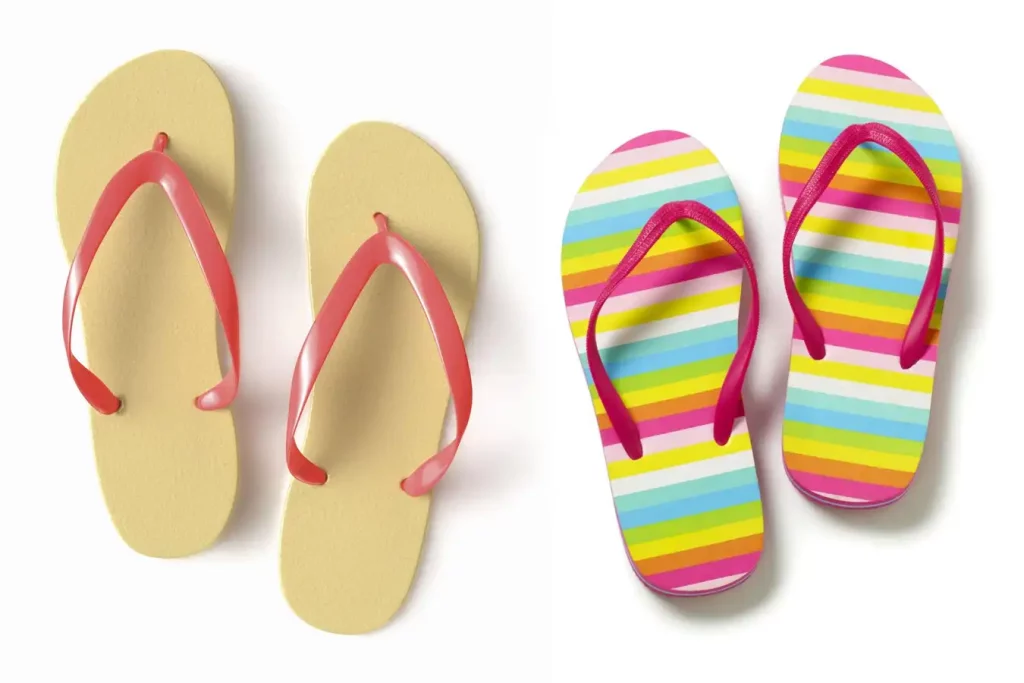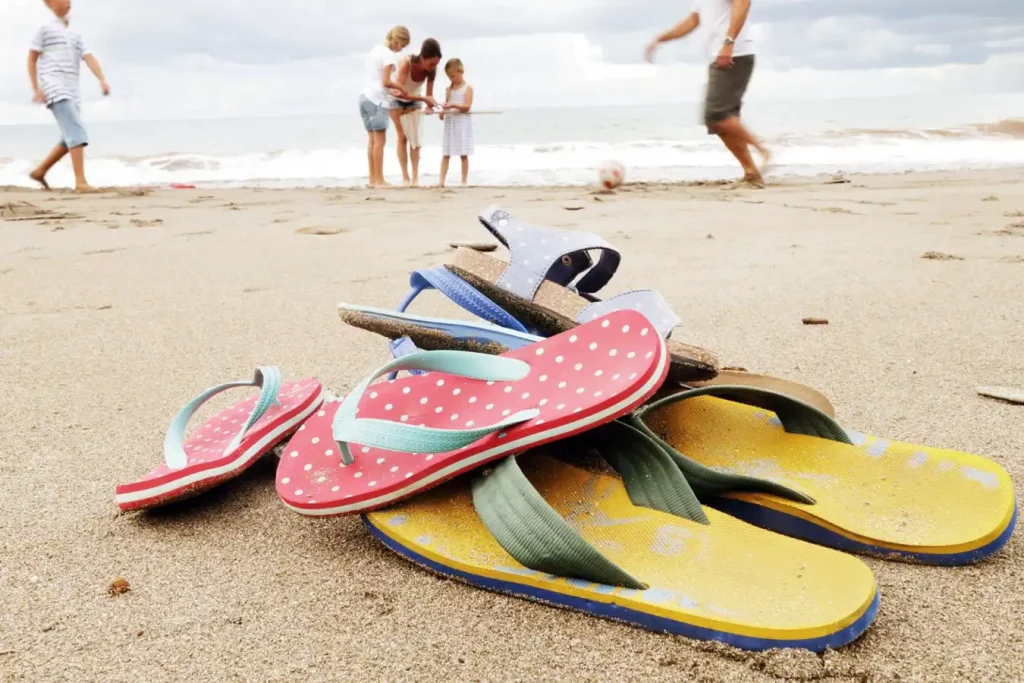“How are sandals supposed to fit?” is more than just a passing thought when summer rolls around.
We’ve all been there: those trendy sandals that looked great but left blisters in their wake.
Or that ultra-comfy pair that… well, looked ultra-comfy and not much else.
Getting the right fit is a dance between style, comfort, and, dare I say, foot health.
You see, there’s an art to ensuring your sandals feel as good as they look.
So, let’s put our best foot forward and uncover the secrets to that perfect sandal fit!
Understanding Sandal Anatomy
Before we begin, it’s crucial to get acquainted with the different parts of a sandal and their roles in fit. This will aid you in your quest for the perfect sandal and ensure you make an informed decision.
Parts of a Sandal and Their Roles in Fit
- Sole: This is the base of the sandal that your foot rests on. A properly fitted sole ensures that your foot doesn’t hang off the edge of the sandal, which can lead to stubbed toes and other mishaps. It should match the shape and size of your foot as closely as possible.
- Straps: Straps hold your foot in place. They can be located at various positions – over the toes, across the foot, or around the ankle. The straps should feel secure but not too tight. If they dig into your skin or cause any discomfort, that’s a clear sign that the sandal doesn’t fit properly.
- Arch Support: This is particularly crucial for those with high arches or flat feet. The arch support should align well with the shape of your foot to distribute weight evenly and avoid undue strain on your feet.
- Heel: Some sandals, like wedges or high-heeled ones, have raised heels. When it comes to these, balance is key. You should feel stable and confident while walking, not wobbly or uncertain.
Variations in Sandal Styles and How They Impact Fit
Not all sandals are created equal, and different styles can impact the fit. For example, flip-flops are easy to slip on, but their lack of support and security can lead to foot pain if worn for prolonged periods. Gladiator sandals, on the other hand, have multiple straps that provide a secure fit, but can be too tight or restrictive for some people.
Slide sandals are all the rage right now, but the wide, single strap design doesn’t provide the best hold. You may find your feet constantly sliding forward or your toes involuntarily clenching the sandal to keep it in place.
Imagine wearing a pair of strappy wedge sandals for a beach wedding. You look fabulous but by the end of the night, you’re limping because the straps are too tight and the wedge heel doesn’t provide enough stability. You then realize that style should never come at the cost of comfort and fit.
Factors to Consider for a Proper Sandal Fit
Choosing a sandal that fits you perfectly can be quite a journey. It’s not as simple as picking your favorite color or design. Let’s look at some of the most important factors that you should take into consideration.
Foot Measurements: Length, Width, and Arch
Just like you wouldn’t buy a shirt without knowing your size, you shouldn’t buy sandals without knowing your foot measurements. The length of your foot determines your shoe size, but the width and arch are equally important, especially for sandals.
- Length: Sandals should neither be too long nor too short. Your heel should rest comfortably at the back edge of the sole, and there should be a thumb’s width of space between your longest toe and the front edge.
- Width: The width of your foot should align well with the width of the sandal. If your foot hangs over the sides of the sandal, it’s too narrow. If the sandal feels too roomy, it’s too wide.
- Arch: Arch support is vital for maintaining proper foot alignment and preventing discomfort or injury. If you have flat feet, choose a sandal with built-in arch support. If you have high arches, look for sandals with a thick, cushioned sole.
Considering Foot Shape and Unique Foot Conditions
Everyone’s feet are unique. Some people have long toes, others have wide forefeet, and some might have certain foot conditions like bunions, hammertoes, or plantar fasciitis. All these factors should be taken into consideration when choosing sandals. For instance, if you have bunions, opt for sandals with soft, stretchy materials or wide toe boxes to avoid pressure on the bunion area.
The Right Fit: Guidelines for Different Types of Sandals
There are countless styles of sandals out there, each with its unique fit considerations. Here are some guidelines for fitting different types of sandals.

Fitting Flip-flops and Slides
For flip-flops and slides, it’s all about the width and length. Ensure your foot fits entirely on the sole, without any overhang. The straps should rest comfortably against your foot without rubbing or pinching.
Fitting Strappy Sandals and Gladiators
Strappy sandals and gladiators offer more security, but it’s crucial to check the fit of each strap. They should be snug but not tight. If you see bulges or feel pressure, it’s a sign that the sandals are too tight. Also, make sure the zipper or buckle doesn’t dig into your heel or ankle.
Fitting Sport Sandals
Sport sandals usually come with adjustable straps, which is a plus. Make sure the sole gives you ample cushioning and the straps can be adjusted to fit your foot securely without causing discomfort.
Fitting Wedge and Heeled Sandals
With wedges or heeled sandals, balance is key. Your foot should feel secure, and you shouldn’t feel as if you’re teetering. Also, check for sufficient toe room. Your toes shouldn’t be hanging off the front of the sandals.
How Are Sandals Supposed to Fit
When you’re trying to find the perfect sandal fit, keep these tips in mind:
- Length: Your foot should not hang off the edge. There should be about a 1/2 inch between your longest toe (which isn’t always the big toe) and the end of the sandal.
- Width: Sandals should be wide enough so that your feet don’t spill over the sides, but not so wide that your feet shift around while you walk. The straps should hold your feet securely in place.
- Straps: Straps shouldn’t dig into your feet or cause any discomfort or blisters. Make sure the strap placement doesn’t irritate your foot or any potential problem areas.
- Arch Support: This varies depending on the person and the style of the sandal. Some sandals offer arch support, which can be important for comfort and foot health. If you have flat feet or high arches, you may want to consider sandals with appropriate support.
Now, let’s move to the sandal size table. Keep in mind, sizes can vary between brands, and this is a general guideline. Always try on sandals to ensure the best fit.
| US Size | Foot Length (Inches) | Foot Length (Centimeters) |
|---|---|---|
| 5 | 8.66 | 22 |
| 6 | 9.06 | 23 |
| 7 | 9.45 | 24 |
| 8 | 9.65 | 24.5 |
| 9 | 9.84 | 25 |
| 10 | 10.04 | 25.5 |
| 11 | 10.24 | 26 |
| 12 | 10.43 | 26.5 |
| 13 | 10.63 | 27 |
| 14 | 10.83 | 27.5 |
If you’re in between sizes, it’s typically recommended to size up for the best fit. For example, if your foot is 9.5 inches long, you would likely be more comfortable in a US size 9 sandal than a US size 8.
Know more: How Do Salomon Shoes Fit
Common Misconceptions About Sandal Fit
When it comes to sandals, there are a few misconceptions that need to be debunked.
Debunking Myths About Breaking In Sandals
One common belief is that it’s okay if sandals are a little tight because they’ll stretch out or “break in” over time. This is not always true, and it’s better to choose a pair that fits well from the start. Uncomfortable sandals can cause blisters, calluses, or even long-term foot problems.
Addressing Beliefs About Oversized or Undersized Sandals
Some people believe that oversized sandals provide more comfort, or that downsizing can make their feet look smaller. These are myths. Oversized sandals can cause tripping or accidents, while undersized ones can lead to foot pain and issues like hammertoes or bunions. It’s essential to choose sandals that fit properly to ensure comfort and avoid foot problems.
Remember, when it comes to sandals, the perfect fit is a balance of comfort, style, and proper support. Keep these points in mind, and you’ll be well on your way to finding your ideal pair of sandals.
Read more: How Do Hoka Shoes Fit
Impact of Poorly Fitted Sandals on Foot Health
When you don sandals that don’t fit well, you may face more than just immediate discomfort. The effects can range from short-term issues to long-term foot problems.
Short-Term and Long-Term Effects of Improperly Fitted Sandals
In the short term, you may deal with blisters, calluses, or bruising from tight straps or insufficient footbed support. You may also experience foot fatigue or pain after walking for extended periods.
Over the long term, the consequences of wearing ill-fitting sandals can be severe. Persistent discomfort can develop into chronic pain or cause conditions like plantar fasciitis. Poor arch support can lead to flat feet or fallen arches. Even your posture and walking style can be negatively impacted by constantly wearing poorly fitted sandals.
Common Foot Problems from Wearing Incorrectly Sized Sandals
Common foot problems that arise from wearing incorrectly sized sandals include corns, bunions, and hammertoes, often resulting from excessive pressure and friction. Athlete’s foot or other fungal infections can also occur due to the foot’s prolonged exposure to unhygienic conditions when the sandals are too tight or too loose.
Tips for Shopping for the Perfectly Fitted Sandals
Now that we understand the impact of poorly fitted sandals let’s move onto some tips that can help you shop for that perfect pair.
The Best Time of the Day to Try On Sandals
Ever noticed how your feet feel a bit swollen after a long day? This is why it’s best to try on new sandals in the afternoon or evening when your feet are at their largest. This ensures that your sandals won’t feel too tight when your feet swell slightly during a typical day.
Trying On Sandals with Intended Socks or Insoles
If you intend to wear socks or insoles with your sandals, make sure to bring them along when you’re shopping. They can significantly affect the fit of the sandals, and it’s important to know that the combination feels comfortable.
Walking Test: How to Assess Sandal Comfort and Fit
When trying on sandals, don’t just stand there—walk around! This helps you assess the sandals’ comfort and fit during actual use. Pay attention to any slipping, rubbing, or pinching, which could lead to blisters or calluses.
FAQs about How Are Sandals Supposed to Fit
How much room should be at the end of a sandal?
Is it better to size up or down in sandals?
How do I know if my sandals are too small?
Are sandals meant to fit like shoes?
Conclusion
It’s important to remember that a well-fitted sandal is crucial, not just for the sake of comfort, but also for the overall health of your feet. Too often, we’re lured by stylish designs and forget about the fit and comfort. The best sandals, however, will provide a balance of style, comfort, and support.
So the next time you’re out sandal shopping, keep these tips in mind and give your feet the care they deserve. Happy sandal hunting!
To know more: How Do I Know if My Hoka Shoes Are Wide


